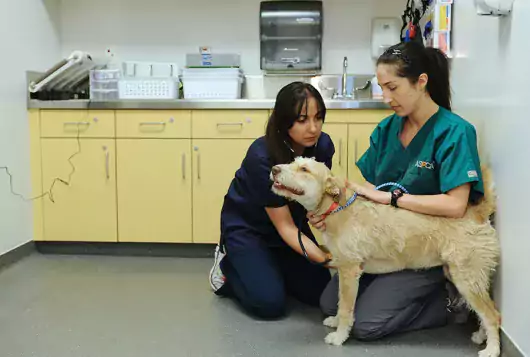Canine Distemper Virus

Canine distemper virus (CDV) causes a highly contagious disease that can be fatal. Although infection is largely preventable through vaccination, CDV outbreaks remain one of the most fatal, resource-intensive and challenging infectious diseases to manage in shelters.
What You Should Know
CDV infections can easily be mistaken for CIRDC or “kennel cough” infections. Clinical signs are often indistinguishable from those caused by other CIRDC pathogens. Some dogs, particularly those with partial immunity, may develop subclinical infections where they can shed infectious virus but do not show outward signs of illness.
More severe signs and clinical progression may also be seen, particularly in puppies. As CDV infection progresses, it can result in a wide variety of clinical signs and levels of severity, including respiratory, gastrointestinal, and neurologic signs in infected dogs.
Clinical signs can include:
- Upper respiratory signs (eye or nose discharge, coughing, sneezing)
- Vomiting
- Diarrhea
- Lethargy
- Decreased appetite
- Neck/back pain, stiffness
- Twitching or seizures (myoclonus is highly suggestive of CDV infection)
CDV is shed in all body secretions of acutely infected animals. It most commonly spreads through direct contact between infected dogs and susceptible dogs or aerosol transmission via airborne respiratory droplets (emitted from coughing or sneezing). It can also be transmitted by fomites such as hands, feet, equipment, or contaminated surfaces.
Incubation and Shedding Periods
The incubation period is usually 1-2 weeks from the time of exposure to development of clinical signs, but it can be as long as 6 weeks. Not every infected dog will show outward signs of illness, and substantial viral shedding can occur in sub-clinical or mildly affected animals. Many dogs will also shed virus for weeks or even months after recovery (up to 4 months). Therefore, careful isolation of all dogs with upper respiratory signs is especially important in a shelter where distemper is a concern.
Zoonotic Potential
This disease is not known to infect humans.
While several diagnostic tests exist, the most practical and commonly used test for diagnosing CDV is a respiratory PCR (polymerase chain reaction) panel, available through most commercial laboratories. This test utilizes nasal, deep pharyngeal, and conjunctival swabs to detect viral nucleic acid. Positive results can be difficult to interpret due to the possibility of false positives associated with recent vaccination with a modified live distemper vaccine, and results should always be interpreted by a veterinarian familiar with the shelter population.
Key few points to consider when collecting and submitting samples for respiratory pathogen PCR testing are:
- Samples should be collected from dogs exhibiting clinical signs of disease, as early in the course of infection as possible and before starting antibiotics.
- Following proper sample collection techniques will provide the most accurate test results.
- Selecting a PCR panel that includes quantitative distemper results will provide information about the amount of virus detected (also known as viral load). This information is very valuable for interpretation of test results and determining whether a positive result could be related to recent vaccination.
If dogs die or are euthanized a complete necropsy should be performed with appropriate samples collected, e.g. upper and lower respiratory tract tissue. Post mortem testing can be the most efficient and reliable means to definitely diagnose CDV in an individual animal and a population.
Individual Animal Care
The mainstay of CDV treatment consists of supportive care as the viral infection runs its course. All treatments should be conducted under the direct guidance of a licensed veterinarian. Depending on available resources and presenting clinical signs, treatments include:
- Intensive nursing care
- Fluid replacement and vascular support
- Nutrition
- Treatment or prevention of secondary bacterial infections
Dogs who have not developed neurologic disease generally have the best prognosis for recovery. All treatments should be carried out under the direct guidance of a licensed veterinarian.
For additional information about treatment of individual dogs, please check out the Individual Patient Care resource.
Population Considerations
The risk of contagion to other animals, along with the individual animal’s prognosis and welfare, needs to be examined in all cases where treatment is being considered. Shelters must consider how a long stay in isolation during treatment impacts an animal’s welfare and ensure appropriate housing and care to maintain behavioral well-being. If shelter resources cannot provide effective treatment and isolation and there are no alternatives for off-site treatment or placement, humane euthanasia should be considered in confirmed cases of CDV.
Disease Outbreak Management
The goal of managing CDV in the shelter is to break the cycle of transmission between the current exposed dog population and any unexposed dogs, including new intakes. Vaccination, prompt recognition of disease, and aggressive responses that are well coordinated between the operational and medical staff are essential. Diagnostic testing is a critical component in identifying infected dogs and appropriate managing an outbreak. Risk assessments (ideally using antibody titer testing) should be used to minimize the amount of quarantine, euthanasia, and other costly measures taken while still effectively controlling an outbreak.
The ASPCA Shelter Medicine Services team is available for consultations on CDV and other infectious diseases.
Recovery
After recovery, dogs may shed the virus for as long as 4 months and can pose a risk to unprotected dogs. Foster placement can be an excellent option for managing these cases, by preventing longer stays in shelter isolation and helping to meet behavior and medical needs.
Ideally, PCR testing should be performed as soon as clinical signs resolve. A negative result suggests that the dog is less likely to be infectious and can be considered a low-risk to other dogs. Serial quantitative PCR testing can help determine when recovered dogs can be released from isolation.
For additional information about managing CDV in a population, please check out the CDV Population Level Management resource.
Vaccinate
Vaccination at or prior to intake is the cornerstone of CDV prevention in a shelter. Vaccinate puppies with a modified-live or recombinant CDV, Adenovirus-2 and Parvovirus (DA2P) vaccine, starting at 4 weeks of age and repeating vaccination every 2 weeks, until 20 weeks of age. For dogs over 20 weeks of age, it is advisable to repeat the vaccination in 2 weeks.
Identify and Separate Sick Animals
Daily rounds are key to promptly recognizing signs of illness in individual animals, patterns within the population and additional red flags that raise the index of suspicion of a potential CDV outbreak, including:
- Increased frequency, severity or duration of Canine Infectious Respiratory Disease Complex cases
- Sudden death (particularly in puppies)
- Gastrointestinal signs (vomiting, diarrhea) along with CIRDC signs
- Neurological signs (seizures, muscle tremors)
Reduce Overcrowding and Stress
Crowding is undoubtedly the most common risk factor for most shelter diseases. Crowding leads to a greater risk of disease introduction into the population, a higher contact rate, reduced air quality, increased stress, compromised animal care and inadequate housing. Reducing length of stay, utilizing low-stress handling techniques, providing humane housing (i.e., double-compartmented kennels) and ensuring daily enrichment should be standard practices in shelters today and can all help reduce the risk of CDV transmission.
Clean and Disinfect
Routine sanitation protocols are generally adequate to prevent the spread of CDV in the environment. The virus is readily inactivated by most commonly used disinfectants, and it survives only a few hours in the environment at room temperature, or up to a few weeks at colder temperatures. The most important factor in shelter decontamination is the isolation or removal of infected animals.
Additional Resources
- Outbreak Management
- Canine Distemper Virus
- Collection of Swabs for Diagnosis of Respiratory Pathogens by PCR
- Infectious Disease Management in Animal Shelters. 2nd ed.
Downloads
- Canine Vaccination Guidelines
- Canine Distemper Individual Animal Treatment
- Canine Distemper Population Level Treatment
Last Reviewed March 2025






